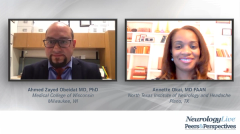
Real-World Data in RRMS With Oral Therapies
Two MS experts discuss how the field is benefiting from availability of real-world data, given the absence of head-to-head trials.
Episodes in this series

Ahmed Zayed Obeidat, MD, PhD: I want to pick on clinical trials a little because I run several clinical trials, and I’m often looking for ideal situations. We look at inclusion and exclusion criteria, and we have to go through them, and patients have to qualify to be in a clinical trial. But when we are in our clinic day-to-day, many of our patients would not qualify for clinical trials based on several comorbidities, disease duration, relapse rates, or prior treatment. So having real-world data is of great importance to learn about how people we see mostly in clinics would do with these therapies if they were not included in clinical trials. That’s another value of real-world data, more, I would say, generalizability of what we find in those studies. Any more comments on real-world data related to efficacy and even safety?
Annette Okai, MD, FAAN: Definitely. With clinical trials, we both do them and love to do them, but we know that we cherry-pick these patients. But when it comes to the real world, there’s no cherry-picking. If the patient is in your exam room, you have to choose a medication, and they may not fit the ideal patient from the trial. So real-world data are where we get our information to make that decision. How do we get real-world data? We look at databases, we look at registries, and we draw conclusions from that. When it comes to the group of therapies, and speaking of oral therapy specifically, let’s talk about some of the real-world data that we have seen. One thing I’d like to point out is that most of these medications have not gone head-to-head in clinical trials. We cannot compare them in terms of, oh, this medication is better than this medication, because we do not have the data for that. But what we can do is look at real-world data and say, how did it perform in this group, and how did this other medication perform in this group?
Recently we had an MS [multiple sclerosis] conference that showed several posters with real-world data looking at the different oral therapies in the absence of head-to-head clinical trials. It’s hard to do an accurate comparison, but what you can do with real-world data is that you can match cohorts. We use a technique called propensity score matching, where cohorts of patients on different therapies are matched as closely as they can be, accounting for different variables, to have a good set of data to compare to. So, when you use propensity score matching, you are in a way mimicking a trial with 2 sets of patients and looking at them on different sets of drugs. With that, I can speak to the fact that one showed that cladribine compared to fingolimod, dimethyl fumarate, and teriflunomide had an improved annualized relapse rate compared to those 3. Another poster showed that with patients on cladribine, the time to first relapse was also sustained longer and was significant compared to fingolimod. This is one example of where, while we do not have head-to-head data, we can look at patients, match them in terms of their demographics, and see how they do on the various medications, and then use that information to direct how we prescribe our medication to patients over time.
Ahmed Zayed Obeidat, MD, PhD: Thank you for bringing this up, because propensity score matching has been utilized now multiple times, especially in multiple sclerosis and some other fields. As you mentioned, we don’t have many head-to-head clinical trials, so the use of propensity score matching is another way for us to look at real-world data and big registries and databases, like the MSBase and some of the other databases, to get some idea on how we can have some comparative efficacy and even comparative safety, sometimes, between existing medications post approval. It’s a good method, and it’s as good maybe as it can get to for us to be able to compare with real-word data. Again, clinical trials are the gold standard, but there are things like this so that we can have some comparative data we can employ in our practice. Thank you very much for bringing this up.
Propensity score matching is a biostatistical process, and they match the score, as you mentioned, based on several factors. And then, comparably scored patients can be compared on each of the drugs. And we have to compare to 1 drug, so we get scores for 1 drug, and then get another patient with a similar score on another drug and compare, which is something that’s been used in several publications. When I first read this, it was very complex for me to understand, and then later I’m like, “OK, now I get it.” I think this helped me to understand more and more of these publications as they come out to help us and guide in clinical practice.
Annette Okai, MD, FAAN: It also helps us to eliminate most of the biases that may come in when you take 2 separate groups that are not in a controlled randomized trial. When you try to use real-world data and put these patients into groups, there are a lot of biases that may creep in, and this is one way to eliminate most of those and try to get as clean a data set as possible.
Transcript Edited for Clarity
Newsletter
Keep your finger on the pulse of neurology—subscribe to NeurologyLive for expert interviews, new data, and breakthrough treatment updates.





